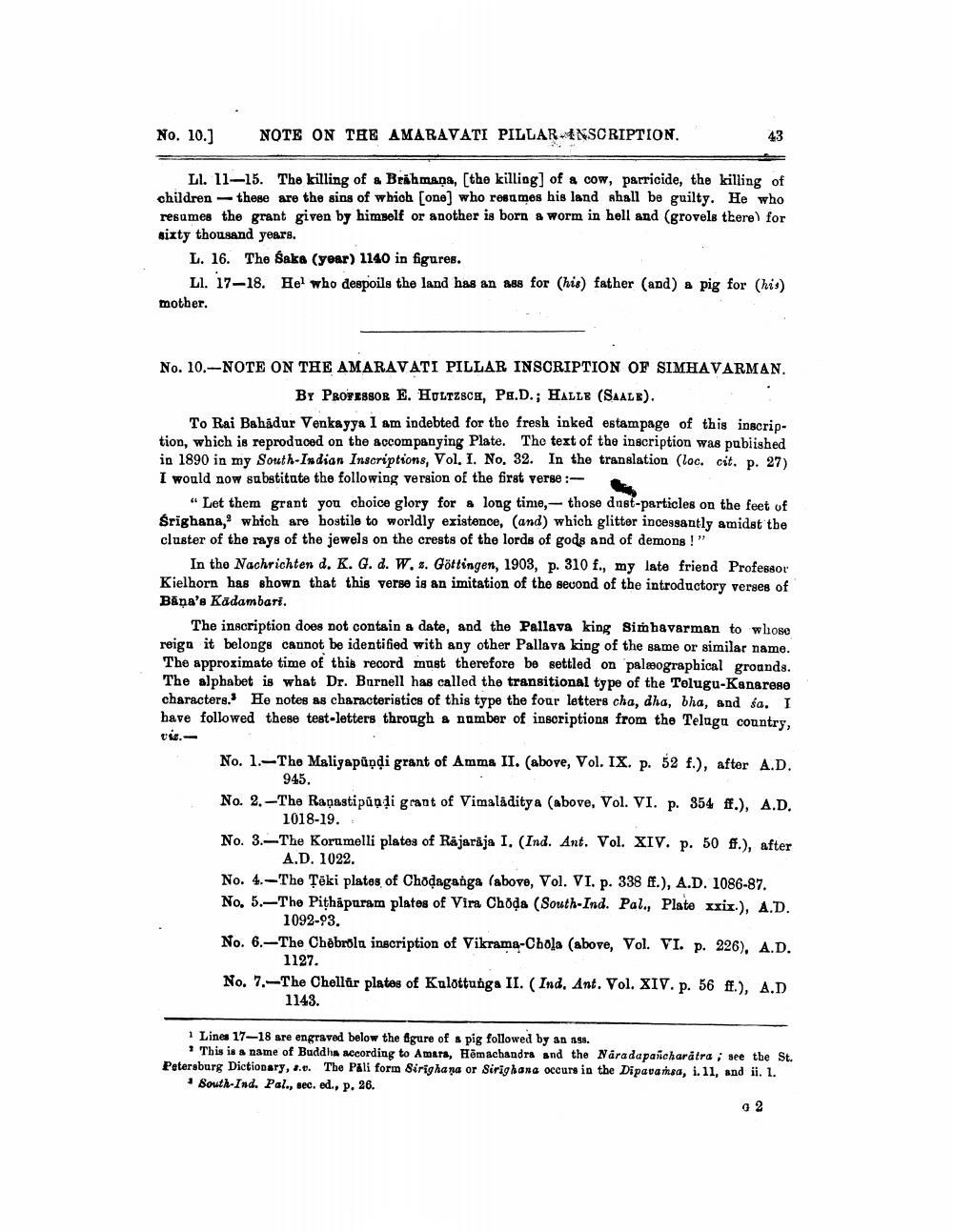________________
No. 10.]
Ll. 11-15. The killing of a Brahmana, [the killing] of a cow, parricide, the killing of children these are the sins of which [one] who resumes his land shall be guilty. He who resumes the grant given by himself or another is born a worm in hell and (grovels there) for sixty thousand years.
NOTE ON THE AMARAVATI PILLAR ANSCRIPTION.
43
L. 16. The Saka (year) 1140 in figures.
Ll. 17-18. He who despoils the land has an ass for (his) father (and) a pig for (his) mother.
No. 10.-NOTE ON THE AMARAVATI PILLAR INSCRIPTION OF SIMHAVARMAN. BY PROFESSOR E. HULTZSCH, PH.D.; HALLE (SAALE).
To Rai Bahadur Venkayya I am indebted for the fresh inked estampage of this inscription, which is reproduced on the accompanying Plate. The text of the inscription was published in 1890 in my South-Indian Inscriptions, Vol. I. No. 32. In the translation (loc. cit. p. 27) I would now substitute the following version of the first verse:
"Let them grant you choice glory for a long time, those dust-particles on the feet of Śrighana, which are hostile to worldly existence, (and) which glitter incessantly amidst the cluster of the rays of the jewels on the crests of the lords of gods and of demons!"
In the Nachrichten d. K. G. d. W. z. Göttingen, 1903, p. 310 f., my late friend Professor Kielhorn has shown that this verse is an imitation of the second of the introductory verses of Bana's Kadambari.
The inscription does not contain a date, and the Pallava king Simhavarman to whose reign it belongs cannot be identified with any other Pallava king of the same or similar name. The approximate time of this record must therefore be settled on paleographical grounds. The alphabet is what Dr. Burnell has called the transitional type of the Telugu-Kanarese characters. He notes as characteristics of this type the four letters cha, dha, bha, and sa. I have followed these test-letters through a number of inscriptions from the Telugu country,
viz.
No. 1.-The Maliyapüṇḍi grant of Amma II. (above, Vol. IX. p. 52 f.), after A.D.
945.
No. 2.-The Raṇastipuṇḍi grant of Vimaladitya (above, Vol. VI. p. 354 ff.), A.D. 1018-19.
No. 3.-The Korumelli plates of Rajaraja I. (Ind. Ant. Vol. XIV. p. 50 ff.), after A.D. 1022.
No. 4.-The Teki plates of Chodaganga (above, Vol. VI. p. 338 ff.), A.D. 1086-87. No. 5.-The Pithapuram plates of Vira Choda (South-Ind. Pal., Plate xxix.), A.D. 1092-93.
No. 6.-The Chebrola inscription of Vikrama-Chola (above, Vol. VI. p. 226), A.D.
1127.
No. 7.-The Chellar plates of Kulottunga II. (Ind. Ant. Vol. XIV. p. 56 ff.), A.D 1143.
1 Lines 17-18 are engraved below the figure of a pig followed by an ass.
This is a name of Buddha according to Amara, Hemachandra and the Naradapancharatra; see the St. Petersburg Dictionary, a.e. The Pali form Sirighana or Sirighana occurs in the Dipavamsa, i. 11, and ii. 1.
South-Ind. Pal., sec. ed., p. 26.
0 2




